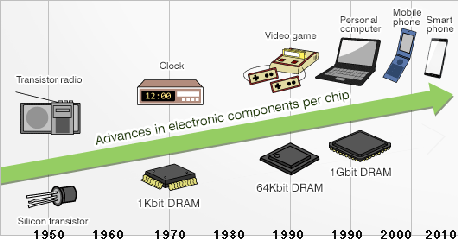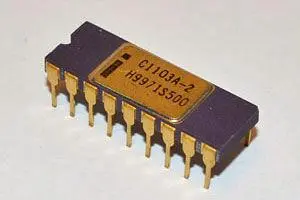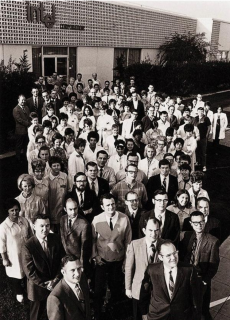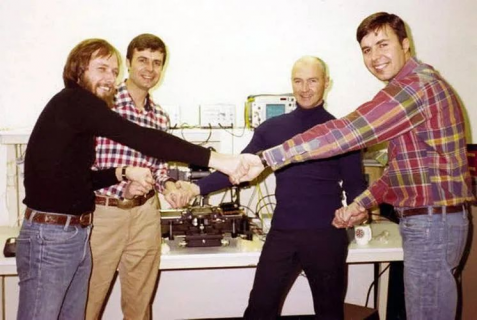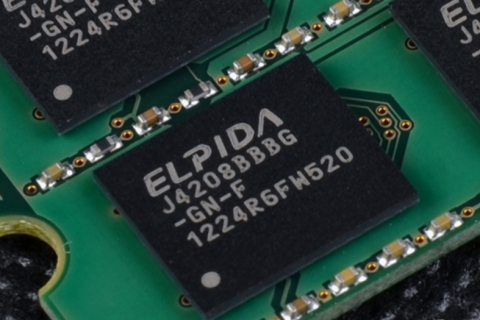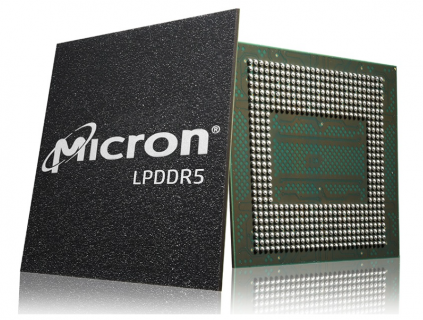Understand the development history of memory chips in one article
On September 12, 1958, Jack Kilby from Texas Instruments successfully integrated five components, including germanium transistors, to produce the world's first germanium integrated circuit.
In July of the following year, Robert Norton Noyce of Fairchild Semiconductor of the United States successfully invented the world's first silicon integrated circuit based on the silicon plane process.
Understand the development history of memory chips in one article
Jack Kilby (left), Robert Noyce (right)
As we all know now, the inventions of these two bigwigs are of great significance. The emergence of integrated circuits has strongly promoted the miniaturization of electronic devices and laid the foundation for the comprehensive arrival of the chip era.
█ Birth of DRAM
After entering the 1960s, with the development of computer technology, the electronics industry began to try to use integrated circuit technology in the field of computer storage.
At that time, semiconductor storage technology was divided into two directions: ROM and RAM. ROM is read-only memory, the stored data will not be lost due to power failure, also known as external memory. RAM is random access memory, which is used to store operation data. After the power is turned off, the data will be lost, also known as memory.
Today, we focus on the field of RAM.
In 1966, Robert H. Dennard from IBM Thomas J. Watson Research Center was the first to invent DRAM memory (Dynamic Random Access Memory).
Robert Dennard
This kind of memory is based on the "MOS transistor + capacitor structure", and has the characteristics of low energy consumption, fast read and write speed and high integration. Until now, our computer memory, mobile phone memory, graphics card memory, etc. are all based on DRAM technology.
In June 1968, IBM registered a patent for transistor DRAM. However, just as they were preparing to industrialize DRAM, the U.S. Department of Justice launched an antitrust investigation against them.
These investigations have delayed IBM's DRAM industrialization progress, thereby creating opportunities for other companies.
Soon after, in 1969, the Advanced Memory System company in California took the lead and successfully produced the world's first DRAM chip (with a capacity of only 1KB) and sold it to the computer manufacturer Honeywell. (Honeywell).
After Honeywell received the batch of DRAM chips, it found that there were some problems in the process. So they found a new company and asked for help.
This company is Intel (Intel) co-founded in 1968 by Robert Noyce (the inventor of the silicon integrated circuit mentioned above) and Gordon Moore (the creator of Moore's Law).
Robert Noyce (left) and Gordon Moore (right)
After the establishment of Intel Corporation, the main business is to develop transistor semiconductor memory chips.
At that time, there were two main research directions in semiconductor technology, namely bipolar transistors and field effect (MOS) transistors. Intel itself does not know which direction is correct, so two research groups were established to follow up two technical directions respectively.
In April 1969, the bipolar group took the lead in making a breakthrough and launched a 64-bit static random access memory (SRAM) chip - C3101. This chip is Intel's first product, and its main customer is Honeywell.
The FET team was not far behind. In July 1969, they launched a 256-bit static random access memory chip - C1101. This is the world's first large-capacity SRAM memory.
In October 1970, the FET team continued to work hard and successfully launched its first DRAM chip (also considered to be the world's first mature commercial DRAM chip) - C1103.
Intel C1103, 18 pins, 1Kbit capacity, $10.
After its launch, C1103 achieved great success and quickly became the world's best-selling semiconductor memory, serving important customers such as HP and DEC.
With the help of the C1103, Intel also grew rapidly. In 1972, Intel had more than 1,000 employees and more than $23 million in annual revenue. In 1974, Intel's global market share of DRAM products reached a staggering 82.9%.
←Intel's early team
While Intel is making a lot of money in DRAM, its competitors are rising rapidly.
In 1973, manufacturers such as Texas Instruments (TI) and Mostek entered the DRAM market successively.
After Intel launched the C1103, Texas Instruments carried out dismantling and imitation, and through reverse engineering, researched the architecture and process of DRAM. Later, in 1971 and 1973, they launched 2K and 4K DRAM successively, becoming a strong opponent of Intel.
Texas→ Instruments, Intel's old rival
Mostek was founded (1969) by L.J.Sevin, the former chief engineer of the Semiconductor Center of Texas Instruments, and its technical prowess is equally impressive.
In 1973, they launched a 16-pin DRAM product, the MK4096, which also challenged Intel's market position (other companies are 22-pin, and the fewer the pins, the lower the manufacturing cost).
In 1976, Mostek launched the MK4116, which adopted the POLY-II (double-layer polysilicon gate) process and had a capacity of 16K. This product was a huge success, reversing the market competition pattern in one fell swoop, increasing its own DRAM market share to 75%.
MK4116
Unfortunately, not long after, due to hostile takeovers from the capital market, Mostek's shareholding structure changed significantly, the management was turbulent, and the technical staff was rapidly lost, and the company soon fell into a trough.
In 1979, the company was acquired by United Technologies Corporation (UTC). Later, it was resold to STMicroelectronics.
In October 1978, four Mostek technicians left to co-found a new storage technology company in the basement of a dental practice in Idaho.
This company, which later became the storage giant, Micron.
Micron's founding team
█ Success and failure of Japanese semiconductors
In addition to domestic competitors, Intel faces a bigger threat from abroad. More specifically, from - Japan.
In the 1970s, Japan's economy grew rapidly. In order to occupy a favorable position in the global technology industry chain, they have made a careful layout in the field of semiconductor technology.
In 1976, Japan established a VLSI joint research and development body through a national system (VLSI: THE VERY LARGE SCALE INTEGRATED, very large-scale integration).
The joint research and development body has a total of 6 laboratories, which are specialized in research in the fields of high-precision processing technology, silicon crystallization technology, process processing technology, monitoring and evaluation technology, and device design technology.
Soon after, this joint research and development body successfully conquered the core semiconductor processing equipment such as electron beam lithography machine and dry etching device, as well as leading process technology and semiconductor design capabilities, laying the foundation for the take-off of the Japanese semiconductor industry.
In 1977, with the help of the VLSI project, Japan successfully developed 64K DRAM, tying the research and development progress of American companies.
In the 1980s, Japanese manufacturers (Fujitsu, Hitachi, Mitsubishi, NEC, Toshiba, etc.) continued to exert their efforts, and began to overtake American companies by virtue of their quality and price advantages.
In 1986, Japan's global market share of memory products rose to 65%, while the United States dropped to 30%.
Under the fierce market competition, Intel Corporation of the United States directly announced that it had abandoned the DRAM market (1985). The only one that can survive in the cracks of Japanese manufacturers is Motorola.
The mantis catches the cicada, followed by the oriole. Just when Japanese semiconductor manufacturers were about to unify the rivers and lakes, the external political environment began to undergo subtle changes.
In 1985, the atmosphere of the Cold War between the United States and the Soviet Union continued to weaken, and the trade friction between Japan and the United States continued to increase. Under the pressure of the huge fiscal deficit, the Reagan administration of the United States began to turn its attention to suppressing the Japanese economy.
This year, the United States dominated the famous "Plaza Accord", forcing the yen to appreciate. At the same time, the American Semiconductor Association has also launched anti-dumping lawsuits against Japanese semiconductors and other products. Later, the two countries reached an agreement on price monitoring of Japanese semiconductor products.
Under the successive blows, the market share of Japanese semiconductor products plummeted and soon lost its dominance.
█ The rise of Korean semiconductors
So, has the market share given up by Japanese manufacturers been taken away by American manufacturers?
not at all.
As the saying goes, "Mantises catch cicadas, and the oriole is behind", while Japanese manufacturers are losing ground quickly, another American competitor has been killed again, that is, South Korea.
As early as when Japan launched the VLSI project, the Korean government was not idle. They established the Korea Institute of Electronic Technology (KIET) in the Gumi Industrial Zone in North Gyeongsang Province, attracting semiconductor talents from the United States with high salaries and focusing on the development of key technologies for integrated circuits.
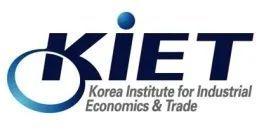 In addition to KIET, South Korean chaebols such as Samsung, LG, Hyundai, and Daewoo also took a fancy to the market prospects of semiconductor technology.
In addition to KIET, South Korean chaebols such as Samsung, LG, Hyundai, and Daewoo also took a fancy to the market prospects of semiconductor technology.
In 1984, Samsung Semiconductor built its first memory factory to mass-produce 64K DRAM. No one thought that this little-known Korean company would become a "Big Mac" in the industry in the future.
In other words, from the 1980s to the present, the DRAM industry has experienced nearly four decades of development. If there is one word to describe these 40 years, it is - "Blood and Bloody Rain".
The reason is very simple. The biggest feature of the DRAM semiconductor industry is its periodicity. Industry insiders once concluded that for every year of DRAM semiconductor storage, it will lose money for two years.
Under such a strong cyclical law, it is very difficult to survive for a long time. DRAM manufacturers need to have strong cash flow and financing capabilities to maintain high-intensity R&D expenditures and maintain team stability.
In a loss-making cycle, DRAM makers need more money to survive. In the boom cycle, it can't be careless. Manufacturers need to be very cautious when choosing when to expand their production capacity. Otherwise, it may lead to oversupply and profit to loss.
Forty years ago, there were about 40-50 DRAM manufacturers in the world. Today, there are only three left, and the brutality of the competition is evident from this.
In the past 40 years, one company has not only persisted in surviving, but also killed countless opponents, occupying a dominant position for a long time. This company is the aforementioned Samsung.
Samsung Electronics →
Samsung's story, some students may have heard of it. They adopted a "killer" strategy that has been written into textbooks by countless business schools—countercyclical investments.
To put it simply, counter-cyclical investment is to take advantage of the cyclical development of the industry. When the industry enters a trough, when competitors shrink in size, they do the opposite, increase investment, expand production capacity, and further suppress prices, thereby reducing prices. Let opponents increase losses, or even go bankrupt.
In other words, everyone burns jade and stone, but I have more money. I burn you to death, and I will continue to live.
The Samsung company, relying on South Korea's national strength, has adopted the "counter-cyclical investment" strategy one after another, killing countless opponents and becoming the leader in the field of semiconductor storage.
Next, let's take a detailed look at what has happened in the past few decades.
The first "countercyclical investment"
Samsung's first "countercyclical investment" occurred in the mid-1980s mentioned above.
At that time, the fierce battle between Japan and the United States was in full swing, the DRAM market was generally sluggish, and prices fell sharply. The price of a DRAM chip dropped from $4 (1984) to $0.3 (1985).
When Samsung built a factory to launch 64K DRAM, the production cost was $1.3 per piece. In the face of the industry's cold winter, Samsung not only did not shrink investment, but began to reverse investment and expand production capacity.
By the end of 1986, Samsung Semiconductor had accumulated losses of 300 million US dollars, and its equity capital was completely deficient, and it was close to bankruptcy.
During the critical period, the South Korean government took action to "rescue the market", investing a total of nearly 350 million US dollars, and endorsed it in the name of the government, bringing in 2 billion US dollars of individual fundraising for Samsung.
Later, Japanese semiconductors were overturned by the United States, and the industry prosperity brought by the entry of PC computers into the hot-selling period made Samsung turn around smoothly and usher in performance growth.
Soon after, Korean DRAM manufacturers, represented by Samsung, gradually eroded the market share ceded by Japanese semiconductor companies, occupying a dominant position in the market.
The second "countercyclical investment"
In 1992, the Sumitomo resin factory in Japan exploded, resulting in a tight supply of raw materials and skyrocketing memory prices. This year, Samsung took the lead in launching the world's first 64M DRAM.
In 1993, the global semiconductor market began to weaken again. At this time, Samsung repeated its old tricks and adopted the second "countercyclical investment". They invested in the construction of an 8-inch silicon wafer production line for the production of DRAM.
In 1995, Microsoft's Windows 95 operating system was released, which greatly stimulated the demand for memory, driving the price of memory to rise sharply, and Samsung's investment paid off. After realizing it, major manufacturers around the world have invested in expanding production capacity.
The good times did not last long. By the end of 1995, after the 8-inch wafer fabs of various manufacturers were put into production, the production capacity increased sharply, but instead, the supply of DRAM exceeded demand. Thus, a seller's market becomes a buyer's market, and prices start to fall again.
In this case, manufacturers are forced to cut production and reduce the scale of investment.
Samsung continues to expand its investments. In 1996, Samsung launched the world's first 1GB DRAM, establishing itself as an industry leader.
From 1996 to 1998, DRAM continued to be in a downward cycle.
In 1999, the downward trend in DRAM prices eased. Because of the emergence of the Internet bubble, the DRAM industry entered a short-lived stage of prosperity.
This year, in the fiercely competitive environment, several major changes have taken place in the memory industry:
In the Korean department, Hyundai Memory merged with LG Semiconductor to form Hyundai Semiconductor, which was later split from Hyundai Group (2001) and renamed Hynix.
In the US department, Micron acquired the memory division of Texas Instruments.
In Japan, the DRAM business of Hitachi, NEC, and Mitsubishi Electric was integrated, and Elpida was established in a group.
In the European department, the semiconductor department of Siemens Group became independent and established Yiheng Technology. A few years later, in 2002, the name was changed to Infineon. Later, in 2006, the memory division of Infineon Technologies was separated and became Qimonda.
In 2000, two of the top five companies in the global DRAM market share were Korean manufacturers, Samsung ranked first (23.00%) and Hyundai ranked third (19.36%).
Soon after, the dot-com bubble burst and the global economic crisis erupted. The PC market has been hit hard, the market demand for DRAM has also dropped sharply, and the price has ushered in another dive.
In 2001, the DRAM market halved from $28.8 billion to $11 billion.
From 2002 to 2006, the DRAM market gradually recovered from the trough, and the overall growth situation was good.
In 2006, Samsung developed the world's first 1GB DRAM with a 50nm process. Hynix developed the world's fastest 200MHz 512MB Mobile DRAM at that time.
During that period, the DRAM market gradually formed a top five structure, namely: Samsung (Korea), SK Hynix (Korea), Qimonda (Germany), Micron (US) and Elpida (Japan).
The third "countercyclical investment"
In 2007, Microsoft launched the Vista system. The system consumes a lot of memory, and DRAM manufacturers expect a huge increase in memory demand, so they have increased production capacity.
But in fact, Vista sales are very poor, did not drive the memory market, resulting in excess capacity again.
What is even more tragic is that in 2008, the financial crisis broke out, which made the DRAM market even worse. Memory prices have fallen all the way, even below the cost of materials.
During this critical period, Samsung resorted to the "counter-cyclical investment" for the third time to further expand production capacity and aggravate industry losses.
In the spring of 2009, the third-ranked German manufacturer Qimonda declared bankruptcy and European manufacturers officially withdrew from the DRAM market.
In 2011, DRAM supply again exceeded actual demand and prices plummeted. This time, Elpida failed to survive and declared bankruptcy, marking the complete withdrawal of Japanese manufacturers from the DRAM industry.
Elpida chip
As a result, the top five became the top three, and only Samsung (Korea), Micron (US), and Hynix (Korea) were left in the DRAM field. The combined market share of the three companies exceeds 93%.
█ Status of DRAM Technology
After 2011, the market structure of DRAM memory has not undergone any major changes. However, the user needs and market environment of DRAM have changed a lot.
In addition to traditional PCs, with the rapid development of the mobile Internet and the Internet of Things, smartphones, wearable devices, and Internet of Things devices (cameras, etc.) have risen rapidly, which has greatly driven the demand for DRAM.
The development of cloud computing, big data and AI artificial intelligence has driven the increase in the number of data centers, which has brought about a sharp increase in servers and network equipment, and also stimulated the growth of DRAM sales.
These demands have gradually subdivided DRAM into standard DRAM, mobile DRAM, graphics DRAM, and niche DRAM.
Standard DRAM is mainly used in PCs, servers, etc. Mobile DRAM is mainly LPDDR, which is used in scenarios such as smartphones and tablet computers. Graphics DDR is used for the graphics memory (GDDR) of the graphics card. Niche DRAM is mainly used in LCD TVs, digital set-top boxes, network players and other products.
LPDDR
The strong demand for multi-product scenarios has driven up the price of DRAM. Around 2018, the demand for digital currencies such as Bitcoin exploded, and the DRAM market ushered in a rare "golden period".
After 2019, memory prices fell more due to early capacity expansion and destocking. The collapse of cryptocurrency market prices and the maturity of the smartphone market have made market demand weak, and DRAM has once again entered a trough.
According to data released by relevant agencies, from the second half of 2020 to May 2022, it is a period of improvement for the DRAM market.
Since June this year, the DRAM market has plummeted. Sales fell by 36% in June and 21% in July, which can be said to be a complete collapse and terrible. According to agency forecasts, the decline will further expand in the fourth quarter.
DRAM market plummets
Next, let's take a look at the development of DRAM over the years from a technical point of view.
For a long time, DRAM chips have been miniaturized to increase the storage density.
Every time the DRAM process is updated, a lot of investment is required.
Taking the update from 30nm to 20nm as an example, the number of photolithography masks required for the latter has increased by 30%, and the number of non-lithography process steps has doubled. The requirements for the area of clean room workshops have also increased by more than 80% with the increase in the number of equipment.
Previously, these costs could be compensated for by more chip output per wafer and the performance premium. However, as processes continue to shrink, the gap between increased cost and revenue is gradually narrowing.
Around 2013, when the process technology entered 20nm, the manufacturing difficulty increased significantly. After 18/16nm, the size reduction in the two-dimensional direction no longer has the advantages of cost and performance.
As a result, DRAM chip manufacturers began to take a different approach and began to study the expansion capability in the Z direction. That is, start advancing 3D packaging.
As an industry leader, Samsung took the lead in realizing 3D DRAM from a packaging perspective. They use TSV packaging technology to stack multiple DRAM chips, thereby greatly improving the capacity and performance of a single memory stick. Later, various manufacturers followed suit, and 3D DRAM became the mainstream.
In terms of product standards, the industry generally adopts the product standards formulated by the Solid State Technology Association (JEDEC), which are known as DDR1-DDR5.
The three DRAM giants all have the mass production capacity of DDR5/LPDDR5. Samsung is tinkering with DDR6, with the design said to be complete by 2024.
In terms of chip technology, the current expression of DRAM is different from the previous one. In the past, it was directly called 40nm and 20nm. Now, because the circuit structure is three-dimensional, linear measures no longer apply, and terms such as 1X, 1Y, 1Z, 1α, 1β, 1γ appear to express the process.
The industry believes that the 10nm~20nm series of processes includes at least six generations. 1X is approximately equivalent to 19nm, 1Y is approximately equivalent to 18nm, 1Z is approximately 16-17nm, and 1α, 1β, 1γ corresponds to 12-14nm (below 15nm).
Samsung, SK Hynix and Micron have entered the 1Xnm stage from 2016 to 2017, the 1Ynm stage from 2018 to 2019, and the 1Znm stage after 2020.
At present, major manufacturers continue to approach 10nm. The latest 1αnm is still in the 10+nm stage.
█ The past and present of China's DRAM industry
Finally, let's take a look at the development of the domestic DRAM industry.
China is one of the important markets for global semiconductor memory, and it is also a "must fight" for global semiconductor memory manufacturers.
However, to be realistic, our own DRAM industry is far behind our competitors.
The start of the domestic DRAM industry can be traced back to the 1990s.
At that time, Japan's NEC established two joint ventures in mainland China to engage in the production of DRAM.
The first is Shougang NEC, a joint venture established by NEC and Shougang in 1991.
Shougang NEC started in 1995, using a 6-inch 1.2-micron process to produce 4M DRAM (later upgraded to 16M). Later, in 1997, the global price of DRAM fell sharply, and Shougang NEC was hit hard, and it has never recovered. Later, Shougang NEC became an overseas foundry base of NEC and withdrew from the DRAM industry.
The second is Hua Hong NEC, a joint venture between NEC and Hua Hong Group in 1997.
Hua Hong NEC started in September 1999, using 8-inch 0.35-micron process technology to produce the mainstream 64M DRAM memory chips at that time. After 2001, as NEC withdrew from the DRAM market, Hua Hong also withdrew from the DRAM industry.
In 2004, China started the second attempt of the DRAM industry. This time, it is SMIC that has taken action.
At that time, SMIC invested and built the first 12-inch wafer fab (Fab4) in mainland China in Beijing. In 2006, it mass-produced the 80nm process and produced DRAM for Qimonda and Elpida.
The good times did not last long. In 2008, due to the adjustment of SMIC's business, it withdrew from the DRAM business. The second attempt failed.
In 2015, China's DRAM purchase amount was about 12 billion US dollars, accounting for 21.6% of the global DRAM supply. The status quo of relying heavily on imports has prompted the third domestic attempt to target the DRAM business.
The most representative of this attempt are the three memory bases in Wuhan, Hefei and Xiamen. With the help of industrial policies at the national and local levels, these bases have invested a lot of capital (more than 250 billion yuan) to develop semiconductor storage technology and cultivate talents.
At present, the representative domestic companies in the DRAM field are Hefei Changxin, Fujian Jinhua, Ziguang Guoxin, Zhaoyi Innovation, Beijing Sicheng, Dongxin Semiconductor, Nanya Technology (Taiwan, China), Winbond Electronics (Taiwan, China) ), PSMC (Taiwan, China), etc.
Hefei Changxin is a leading enterprise of DRAM memory chips in China. Their DRAM technology mainly comes from the bankrupt German DRAM manufacturer Qimonda and the Japanese manufacturer Elpida.
On September 20, 2019, Hefei Changxin announced that the first 12-inch DRAM factory in mainland China was put into operation and released the first 8G DDR4 manufactured by 19nm process, which is a historic breakthrough.
According to the agency's forecast, Hefei Changxin's production capacity is expected to reach 125,000 pieces from 2022 to 2023.
Fujian Jinhua, everyone should have heard of it. A few years ago, they were sanctioned by the U.S. government, and the news made a lot of noise.
In May 2016, Fujian Jinhua cooperated with UMC for the production of niche DRAM. In December 2017, Micron accused Fujian Jinhua and UMC of embezzling their own memory chip technology. In January 2018, Fujian Jinhua also filed a lawsuit against Micron for patent infringement. In October 2018, Fujian Jinhua was included in the list of export controlled entities. In November 2018, the U.S. Department of Justice sued UMC and Fujian Jinhua for stealing Micron’s trade secrets.
After some tossing, UMC couldn't take it anymore. At the end of January 2019, UMC announced the withdrawal of the Fujian Jinhua DRAM project. In November 2021, UMC and Micron reached a settlement. At present, there is no complete final result of the review by Fujian Jinhua.
█ Conclusion
Well, I have written so much, and what I see here is true love.
In short, DRAM memory is an important part of products such as computers and mobile phones, and it is also an indispensable "part" of digital infrastructure.
At present, domestic DRAM memory has basically solved the problem of presence or absence. The next step is to solve the problem of improving the yield rate and the problem of ramping production capacity. In terms of financing capacity, industrial chain support and talent echelon, we need to continue to strengthen and move forward cautiously.
We hope that we can break the "three strong" pattern as soon as possible and occupy a more important position in the DRAM field.
References:
1. "Who will break this DRAM technology dilemma? ", Kaiqi Wang, Global Semiconductor Watch;
2. "The American Romance of DRAM Rivers and Lakes", Xinguang Society;
3. "Storage Technology Development History", Xie Changsheng;
4. "The process of localization of DRAM chips is tortuous and the future is bright", Xiangcai Securities, Wang Pan, Wang Wenrui;
5. "Storage Factory Makes Another Big Gamble", Semiconductor Industry Observation;
6. "Memory Chip Industry Research Report", Guosen Securities;
7. "Domestic Storage Waiting for a Revolution", Fu Bin, Nuohu;
8. "About semiconductor storage, there is nothing more complete than this", Master Xin;
9. "Technology Brief 035 - Flash Memory of Semiconductor Storage", Wu Mijin, Zhihu;
10. Entries related to Baidu Encyclopedia and Wikipedia.

